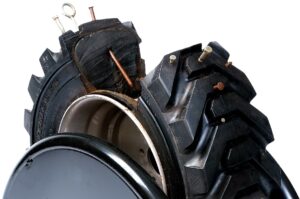In the intricate world of concrete construction, where precision is paramount, every component of the equipment plays a pivotal role in achieving superior results. Among these, the often-overlooked yet critically important feature is the type of tires used on laser screed equipment. Join us as we explore the significance of foam-filled tires and how they contribute to the efficiency, accuracy, and overall performance of laser screeds.
1. Enhanced Stability for Precise Leveling: Foam-filled tires provide a level of stability crucial for the precise operation of laser screeds. The even weight distribution and reduced risk of tire deflation ensure that the equipment maintains a consistent level during the concrete leveling process, resulting in surfaces of unparalleled flatness and levelness.
2. Minimized Downtime and Maintenance: Unlike traditional air-filled tires, foam-filled tires virtually eliminate the risk of punctures, reducing the downtime associated with tire repairs or replacements. This not only enhances the efficiency of the construction project but also minimizes the maintenance costs and disruptions commonly associated with pneumatic tires.
3. Improved Traction on Job Sites: Construction sites often present challenging terrains, from gravel to rough concrete surfaces. Foam-filled tires offer improved traction, enabling laser screeds to navigate diverse job site conditions with ease. This enhanced traction contributes to the seamless operation of the equipment, even in demanding environments.
4. Consistent Performance Across Varied Conditions: The density and composition of foam-filled tires provide a level of consistency in performance across a range of environmental conditions. Whether it’s extreme temperatures or varied terrains, these tires ensure that the laser screed maintains its precision and functionality, delivering reliable results regardless of external factors.
5. Vibration Dampening for Sensitive Components: Laser screeds are intricate pieces of machinery with sensitive electronic components. Foam-filled tires act as shock absorbers, dampening vibrations and minimizing the impact on these critical components. This not only extends the lifespan of the equipment but also contributes to the accuracy of the laser screeding process.
6. Operator Comfort and Safety: The well-being of operators is paramount on any construction site. Foam-filled tires provide a smoother ride, reducing the impact of vibrations on the operator. This not only enhances comfort during operation but also contributes to overall safety by minimizing operator fatigue.
7. Long-Term Cost Savings: While foam-filled tires may represent a slightly higher upfront investment, the long-term cost savings are substantial. The reduction in downtime, maintenance costs, and the extended lifespan of the tires contribute to a more cost-effective solution over the life of the laser screed equipment.
8. Environmental Considerations: Foam-filled tires align with environmental considerations by reducing the need for tire replacements and minimizing the environmental impact associated with traditional tire disposal. This makes them a sustainable choice in the context of modern construction practices.
In conclusion, the choice of tires for laser screed equipment goes beyond mere functionality – it is a key determinant of project success. Foam-filled tires emerge as a smart investment, ensuring stability, reliability, and longevity in laser screed operations. Construction professionals looking to achieve the highest standards of precision and efficiency should consider the indispensable role that foam-filled tires play in optimizing their laser screed equipment.

